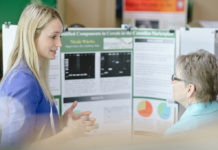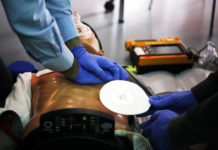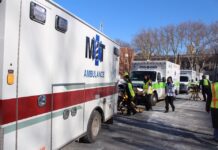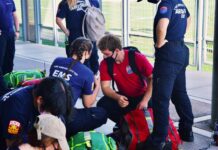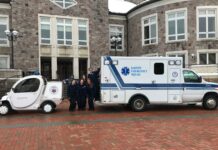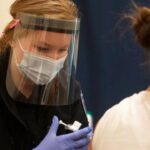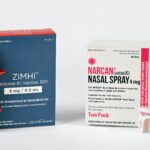Abstract
Background: Predicting emergency medical services (EMS) resource utilization at mass gathering events (MGEs) is challenging. Objectives: This study aimed to examine EMS utilization during MGEs at an urban university with a collegiate-based EMS (CBEMS) agency, and how such utilization may be associated with specific attributes of these events. Methods: This retrospective study was conducted by analyzing the dispatch logs of Georgetown Emergency Response Medical Service (GERMS) for events with a medical standby detail. Environmental factors for each MGE were also analyzed, including: event type, location, event size, the presence of alcohol, and outdoor temperature. Results: Over approximately 5 years (2011-2016), GERMS staffed 406 MGEs and a total of 87 patients were treated. Events with fewer than 500 attendees had no reported medical events, while events with more than 1,000 attendees averaged 0.39 patients-per-event (PPE). Alcohol-free events had 0.05 PPE, while events at which alcohol was consumed had 0.49 PPE (p=0.028). In the subset of outdoor non-sporting events with a minimum of 1,000 attendees, there was a statistically-significant increasing PPE associated with rising temperatures (Pearson’s Correlation Coefficient 0.983; p=0.017). Conclusions: These findings suggest that college event planners can potentially utilize event and weather features to predict EMS resource utilization.
Introduction
A mass gathering event (MGE), typically defined as an event drawing at least 1,000 persons to a specific location, can pose significant challenges for event organizers and emergency medical services (EMS) agencies.1 While medical emergencies can reasonably be expected to occur during MGEs, accurately predicting the number of emergencies and transports can be elusive.2 It remains essential, however, for event planners to ensure that appropriate medical resources are available for the event to respond to participants experiencing acute medical issues.3
Several suggested variables potentially predict the need for EMS at events, including the number of persons attending, weather conditions, and the presence of alcohol.2,4 At least two prediction algorithms have been described, considering these factors.3,5 However, there is little guidance in the literature on how to best anticipate EMS utilization specifically at mid-sized, collegiate settings. The university setting is often different than other mass gathering locations in that colleges are often built as open and inviting places. The college environment also uniquely experiences high-risk behaviors with regards to alcohol by combining high rates of underage consumption6,7 with a hesitation to report acute medical issues due to fear of disciplinary action.8
Universities with college-based EMS (CBEMS) agencies benefit from having timely access to emergency medical care, averaging a response time of 2.6 minutes.9 CBEMS agencies often provide standby coverage for on-campus MGEs. Predicting EMS utilization at these events, however, poses a challenge to CBEMS programs when planning appropriate staffing and resources. Understaffing an event can increase risk to attendees due to delays in accessing emergency medical care. Consistently over-staffing events, however, can become unsustainably expensive for sponsoring institutions.
Objectives
This study aimed to examine EMS resource utilization during MGEs at Georgetown University, a mid-sized urban university with a collegiate-based EMS transport agency with basic life support (BLS) providers (GERMS), and how such utilization may be associated with specific attributes of these events. The investigators hypothesized that temperature, presence of alcohol, and event size would be predictive of EMS utilization.
Methods
In this retrospective chart review, the investigators analyzed the dispatch logs of GERMS during on-campus MGEs. The study setting, Georgetown University, is an urban collegiate EMS system that responds to approximately 900 calls for medical service annually and is the primary provider of medical standby services for the university. GERMS is composed of approximately 100 undergraduate student volunteers. Georgetown University has an undergraduate enrollment of approximately 7,500 students with a campus size of 104 acres. The study period was defined as September 1, 2011 through October 1, 2016. For this study, acute medical issues were defined as any event in which a patient (or bystander) requested medical assistance directly from on-site EMS providers or requested assistance via the GERMS dispatch center (by phone). Electronic records of all patient encounters by GERMS (defined as a patient requesting, or being referred for, assessment due to a stated or obvious medical complaint) are maintained in the GERMS dispatch logs. Patient contacts without assessments (such as an attendee requesting help up a wheelchair ramp) are not included in this study. Multiple calls for the same patient are counted as only one encounter.
To determine potential associations between environmental factors and resource utilization, the investigators also reviewed the agency’s historical standby detail staffing logs. Environmental factors considered included: event type, location, event size, the presence of alcohol, and outdoor temperature. Retrospective temperature from each event was collected from the Old Farmer’s Almanac.10
Linear regression, logistic regression and bivariate correlations were used to determine potential correlational relationships between environmental factors and patient presentation rates to EMS at MGEs using the SPSS Statistics platform (IBM, Armonk, NY). Unpaired t-tests were utilized to examine for statistical significance.
This study’s methodology was reviewed and approved by the Georgetown University Institutional Review Board.
Results
There were 406 unique MGEs during the study period for which GERMS provided medical standby coverage. Estimated crowd size was grouped into three categories (small: less than 500 attendees; medium: 500-1,000 attendees; and large: over 1,000 attendees). The number of MGEs, total number of patients, and patients-per-event (PPE) rate are categorized by event type in Table 1 and categorized by event size in Table 2. The PPE rate is the mean number of patient encounters at each event.3 No acute medical events were reported for MGEs with fewer than 500 attendees. Concerts and graduation activities were associated with the highest PPE rates (1.44 and 0.59 respectively).
Table 1. Patients-Per-Event rates at MGEs covered by GERMS, grouped by event type.
Table 2. Patients-Per-Event rates at MGEs, grouped by estimated crowd size.
The presence of alcohol was also evaluated (Table 3). Events were classified as involving no alcohol consumption, alcohol consumed by attendees (where attendees were likely to have consumed alcohol not provided by event organizers at, or immediately prior to, the event), or alcohol provided by event organizers. Sporting events were considered a separate category due to the wide variability of alcohol availability and consumption.
Table 3. Patients-Per-Event rates at MGEs, grouped by alcohol availability.
Alcohol-free events had the lowest EMS utilization, with 0.05 PPE. Events with alcohol consumption had significantly greater EMS utilization as compared to alcohol-free events (alcohol consumed PPE=0.49; mean difference=0.044; p=0.028). Events in which alcohol was provided had a higher EMS utilization as compared to alcohol-free events but this difference was not statistically significant (alcohol provided PPE=0.27; mean difference=0.22; p=0.165).
Outdoor events with a minimum of 1,000 attendees were classified as sporting versus non-sporting (eg, concert, graduation) events, with the patients-per-event rate calculated and outdoor temperatures identified (Figure 1). In the subset of outdoor non-sporting events, there was a statistically-significant increasing PPE associated with rising temperatures (Pearson’s Correlation Coefficient 0.983; p=0.017). No linear correlation between patients-per-event and temperature was found for outdoor sporting events.
Discussion
This study demonstrates several identifiable patterns for EMS resource utilization for MGEs at an urban, medium-sized university setting. First, while GERMS provided a significant amount of standby resources at small- or medium-sized events, relatively few of these events had acute medical issues requiring EMS resources. Except for concerts, all types of events on average had less than 1 patient-per-event.
The investigators could not reliably distinguish even larger events (such as 1,000 versus 5,000 attendees). However, because of the size of Georgetown University, and limited areas for mass gatherings on campus, it is unlikely that events with significantly more attendees occurred; the largest on-campus venue only seats 2,500 attendees. Outdoor non-sporting events with higher temperatures were associated with more patients per event. Previous studies have demonstrated a similar impact of hotter weather.3,5 Concerts and graduation activities, both outdoor non-sporting events, had the highest numbers of patients-per-event of any MGE group. Given the typically higher temperatures, the authors speculate that graduations are associated with a higher PPE due to a greater incidence of heat-related emergencies. Additionally, the audience present at graduations is likely to be older and have a higher prevalence of pre-existing health conditions that may place them at greater risk of requiring EMS services, when compared to the younger and (likely healthier) students that comprise most other on-campus MGEs. Temperature is an easily obtainable data point in advance of the event and can serve as a valuable tool to aid collegiate event planners in determining appropriate EMS resource allocation.
Outdoor sporting events did not demonstrate this near-linear correlation between temperature and PPE at large MGEs. This weaker relationship may be due to the presence of athletic participants who are better able to withstand adverse heat conditions. The length of the event may have also been a confounding factor as the sporting events were generally shorter in duration than events like concerts and graduations. The investigators were not able to reliably classify alcohol availability at athletic MGEs and thus alcohol could not be used to determine the PPE rate for outdoor sporting events.
Events where attendees consumed alcohol showed a significant increase in the PPE when compared to alcohol-free events. Prior studies have found alcohol-use to be a significant factor in the rate of patient presentations.3,5 Additionally, the drinking-related behaviors in the under-21 population are more impulsive and risky than in older age groups.9 However, events in which alcohol was provided by the event sponsor were not more likely to have acute medical events. This may be due to higher regulation of alcohol consumption by dispensing event staff, or older attendee age. Events in which alcohol was provided on-site were planned for senior students or adult attendees and required age-registration and identification verification in advance of the event.
The findings of this study are consistent with others in the literature. Hartman et al3, for example, found that a heat index of greater than 90°F for outdoor events was significantly predictive for a greater number of patient encounters at MGE’s. Hartman et al also found that events with an older crowd age (>21) required more EMS services, which may explain why the current authors found more patient encounters at graduation activities (which often bring an older age cohort to campus), as compared to racing events (with a relatively younger age cohort).3 Arbon et al similarly found that weather (specifically higher humidity, whereas the current authors investigated temperature alone) can affect the number of patient presentations.5
It is crucial to adequately plan for the medical needs of an MGE to meet the needs of both the attendees and the hosting institution. While understaffing poses a risk of significant delays in emergency care at the event, consistently overstaffing can create a strain on the EMS system. Overstaffing can also become expensive for the host organization if they need to contract with outside EMS to arrange standby services.
This study found that no events with fewer than 500 attendees (albeit, a limited number covered by GERMS) were associated with acute medical issues requiring EMS intervention. In resource-limited settings, this finding suggests that such events may not require any EMS standby personnel coverage. The results also suggest that events in which alcohol is known to be consumed (during or immediately before) require a heightened awareness by event planners of the potential need for EMS coverage.
Appropriately staffing MGEs is especially critical for colleges and universities because they host a wide range of unique events with a specific patient population. In addition, university planners are often less experienced in MGE planning than their counterparts in other large institutions, as many planners are students. The high turnover of university student-organizers compounds the need for a guideline that is accessible and user-friendly to increase standardization and accuracy of event staffing.
Limitations
This study is limited by its retrospective design and relatively small sample size. Over a 5-year period, only 406 MGEs were available for analysis. Only events where organizers had requested GERMS standby services were included in this analysis of MGEs. MGEs that took place on campus but did not request standby EMS services could have been under-represented in this dataset. GERMS also has overlap in its response boundaries with the Georgetown Fire and EMS Department. Any calls resulting from campus MGEs that were dispatched via 911 to Georgetown University would also not be represented in this dataset, potentially underrepresenting the true patients-per-event rate. However, this likely occurred infrequently, as requesting an ambulance via 911 at the studied jurisdiction results in a bill to the patient, while transport by GERMS is free. Moreover, the local Georgetown Fire and EMS department does not provide standby coverage to Georgetown University, further reducing the potential for patients to be transported via 911.
Another potential limitation is the classification of events with alcohol. The distinction between events in which alcohol was likely to be consumed and events in which alcohol was not permitted is not precise.
Conclusions
MGEs continue to pose a challenge to both event organizers and EMS agencies with regards to predicting EMS utilization. Optimization in matching estimated EMS needs with actual medical dispatches enhances the timeliness and quality of care patients experience, while concurrently conserving scarce medical resources. This study highlights the potential for specific features of the event to be identified ahead of time and used to predict EMS resource utilization. In particular, increased medical calls occurred at large, outdoor, non-sporting events with higher temperatures, large crowds, and alcohol consumption, especially if in an unregulated fashion. University administrators, event organizers, and EMS agencies can therefore prepare medical plans for MGEs by determining forecasted temperatures, the event size, and whether alcohol is expected to be consumed.


